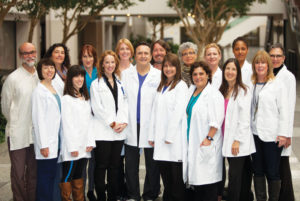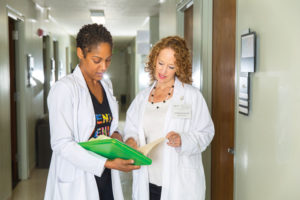Yoga changed my life. At the pinnacle of decades in a high-powered corporate career, the ending of a long-term relationship, and the death of my father, I was diagnosed and then treated for breast cancer. I turned back to my yoga practice, one of the few places I found salvation. Yoga became my “therapy.” That was 11 years ago.
In the ensuing years, I have been in pursuit of the wisdom yoga brings, to live it, and share it with others. My journey to the Loyola Marymount University (LMU) inaugural Yoga Therapy Rx IV (YTRx IV) clinic internship began in 2007 when I took a 200-hour yoga teacher training with Tamal Dodge to deepen my understanding of yoga as a practice from the inside out. The seeds were planted: I wanted more. The fortuitous invitation to leave my corporate position came serendipitously a year later, on the eve of the Prime of Life ™ training developed by Dr. Larry Payne, Ph. D., E-RYT500 YTRX, Executive Director and Founder of the Yoga Therapy Rx and Prime of Life Yoga programs at LMU. My awakening to yoga as therapy led me into the first three Yoga Therapy Rx programs. In the middle of the first year, I took a month-long sabbatical at the Himalayan Institute, where I confirmed my commitment to transforming my life and livelihood to wellness and Yoga Therapy. Subsequent to my Rx II studies, I completed a year long internship at Tensegrity Yoga Therapy with Sherry Brourman and Leslie Kazadi, which influences my teaching and practice today. And during the second year, I opened LiveYoga Wellness, a quaint studio, nestled in the village of Westchester, near LAX, to provide an environment for the local community to inspire and promote wellness.
So enthused by yoga and Yoga Therapy as a healing modality, to qualify for the LMU Yoga Studies master’s degree program, I returned to college to complete my bachelor’s degree at California Institute of Integral Studies, a program fundamentally based on the yogic principles of jnana (discriminative knowledge), inclusion, kindness and compassion, all with an eye toward social justice. Concurrent with my undergraduate studies, in order to broaden my understanding of yoga philosophy, I completed another 200-hour yoga training at Hill Street Yoga & Meditation Center with Dr. Chris Chapple, Doshi Professor at LMU, and Founder of the LMU Yoga Studies program, As a devoted life-ong learner, my studies continue presently in the 1000-hour liv-INg-yoga training developed by Jasmine Lieb, Certified Yoga Teacher and Yoga Therapist. And while my plans for a master’s degree may be realized in the future, it is the practical application of yoga as therapy that is my current interest. Clearly, the natural next step for me was to participate in the YTRx IV program.
In this program, Yoga Therapy interns are part of an integrated medical team that includes: medical doctors, acupuncturists, chiropractors, and other practitioners of the healing arts and sciences. Fellow intern, Ashley McKeachie shares, “This experience provided me with the confidence to work with medical professionals, to explore how we can work together as a team to promote health and well-ness.” When healthcare professionals so often become depleted and diseased in the process of helping others, YTRx IV not only gives us an opportunity to share the benefits of yoga as therapy to a growing population, but also gives us the ability to facilitate an understanding by the healthcare providers themselves. In that spirit, I am grateful to be one of 12 Yoga Therapists, along with Laurie Angress, Karla Balani, Kyona Beatty, Dena D’Angelo, Maureen Davis, Deanna Parameshwari Galkin-Doran, Sharon Holly, RoxAnn Madera, Ashley McKeachie, Rachel Meisel Dvorin, Damon Roberson, and program assistant Megan McCarver, participating in the YTRx IV program. A note of thanks also goes to Kathleen Ross-Allee E-RYT500, YTRX Managing Director, whose participation in the pilot program was instrumental in making YTRxIV possible.
The clinic internship, at the Simms/Mann Health and Wellness Clinic of Venice Family Clinic (S/M VFC), brings credibility and validation of Yoga Therapy as a healing modality into the Western medical model. This training program is possible in part, because of the efforts and beliefs of A Dr. Myles Spar, MD, MPH, director of the Integrative Medicine Program, and Nancy Rodriguez, MPH, clinic and program manager at S/M VFC who invited Yoga Therapy into the integrative medicine program.
What distinguishes Yoga Therapy from Yoga? In a recent Yoga Therapy Today article, Larry Payne explains the biggest difference is that people who choose Yoga Therapy they have special needs that require one-on-one sessions. Yoga Therapists are most effective with people who are in some type of rehab process. We share tools to manage the issues, and help with prevention of future disease.
As Yoga Therapy interns, we work two six-week rotations. A typical clinic day consists of seva (volunteer time), patient case review, an integrated medical team meeting where interns present case studies to the group, followed by three one-hour patient sessions. While patients are referred to us for musculoskeletal issues as part of the integrative chronic pain program, many have multiple disorders, such as hypertension, diabetes, obesity, depression, anxiety, and heart disease. Our evaluations and assessments are yoga-based, looking at the whole person and taking into consideration quality of life, and not just the physical complaint; we also include an evaluation of the energetic, emotional, intellectual and spiritual aspects of the person. At the same time, we are integrating with the Western medical model by including measurements monitoring blood pressure, heart rate, respiratory rate, pain, functional ability, range of motion, balance, and more.
Based on this integrated evaluation, Dr. Lori Rubenstein Fazzio, DPT, PT, MAppSc, YTRX, Clinical Director, and mentor extraordinaire, guides us in designing holistic, comprehensive Yoga Therapy practices that consider all of the koshas, (the physical, mental, emotional, and subtle layers of the body), enhancing our understanding and presentation of Yoga Therapy as a lifestyle management tool, rather than being simply a treatment for specific ailments. The patients we see, along with the medical professionals, are learning that yoga is not just about stretching. We are facilitating a deeper connection to their inner selves through yoga.
Our approach and practices are specific to the patient. For example, as discussed in Patanjali’s Sutra 2.33, we may teach people how to focus on positive opposites, giving them a new perspective in their lives. We may guide them to move with ease, with the breath, giving them a greater sense of balance, strength, and mobility, as well as much needed stress reduction.
Intern Sharon Holly captures the essence of our interactions with the patients when she says, “Showing up and listening is more important than any asana we give them.” Her observation echoes the words of the late great Sri T Krishnamacharya who said, “The most important aspect of healing is the relationship between the teacher and the student.” We notice the people coming into the clinic return week after week with improved body awareness, greater understanding and connection to self, and a growing sense of joy. Their journey mirrors my own, which fills my heart and energizes my soul.
As for the outcomes of our efforts, I agree with Ashley when she says, “I had the great opportunity to work with determined patients who fiercely wanted a better quality of life, and embraced the tools of Yoga Therapy.” At the same time, we educate the patient, family members, and the medical staff. And we’re building bridges through translating asana, bhavana (visualizations), and philosophy into mainstream language for the medical charts. This can be challenging, for example, when working with a patient on opening anahata, the heart chakra, we are writing about thoracic extension. This level of integration is a noteworthy component of this groundbreaking teaching opportunity, as it facilitates our ability to awaken an understanding of the benefits of yoga as therapy in other medical professionals. Although they are slowly learning about what we do, the results speak for themselves.
As a group, by the end of the first year of the program we will have seen 72 patients. The success stories reveal the meaning of yoga practice to the people who have walked through the doors. Someone being treated with depression said that for the first time ever, she believes she could be happy. Another patient, whose blood pressure had been at least 200/90 for the past year despite three different medications, thought her home BP cuff was broken because it has not gone above 165/80 since she has been using the yoga practice we gave her. A third, who finds shelter in his van, told his therapist that he used a gift certificate to purchase a yoga mat and strap so he can practice daily. He has found balance in all aspects of life through yoga. The people at Venice Family Clinic are a portion of the underserved in Los Angeles, and have been cycling through the system over and over, however many of them blossom when they have guidance that empowers them.
Just as yoga as therapy changed my life, I see it change others. Altering the landscape of health care with the recognition of the value of Yoga Therapy gives hope to the future of medicine. And the Yoga Therapy Rx IV program is on the forefront of perpetuating this transformation.
References
Birch, Kelly, “Yoga Therapy Meets Modern Medicine.” Yoga Therapy Today Winter 2013: p. 42. Print. http://www.sytar.org/yttwinter2013/index.html
Desikachar, T.K.V., (1995) The Heart of Yoga: Developing a Personal Practice. Rochester, Vermont: Inner Traditions International.
Teri Roseman, BA, YTRx-500C, POLY-500, CYT, RYT-500 is the executive director and founder of LiveYoga Wellness. She works with clients individually, teaches group and corporate classes, and host workshops and seminars. She is a graduate of the LMU Yoga Therapy Rx IV program.


